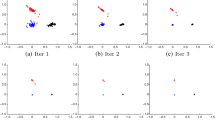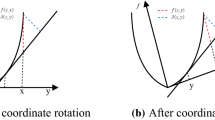Abstract
In this paper, a novel method called fuzzy diffusion maps (FDM) is proposed to evaluate cartoon similarity, which is critical to the applications of cartoon recognition, cartoon clustering and cartoon reusing. We find that the features from heterogeneous sources have different influence on cartoon similarity estimation. In order to take all the features into consideration, a fuzzy consistent relation is presented to convert the preference order of the features into preference degree, from which the weights are calculated. Based on the features and weights, the sum of the squared differences (L2) can be calculated between any cartoon data. However, it has been demonstrated in some research work that the cartoon dataset lies in a low-dimensional manifold, in which the L2 distance cannot evaluate the similarity directly. Unlike the global geodesic distance preserved in Isomap, the local neighboring relationship preserved in Locally Linear Embedding, and the local similarities of neighboring points preserved in Laplacian Eigenmaps, the diffusion maps we adopt preserve diffusion distance summing over all paths of length connecting the two data. As a consequence, this diffusion distance is very robust to noise perturbation. Our experiment in cartoon classification using Receiver Operating Curves shows fuzzy consistent relation's excellent performance on weights assignment. The FDM’s performance on cartoon similarity evaluation is tested on the experiments of cartoon recognition and clustering. The results show that FDM can evaluate the cartoon similarity more precisely and stably compared with other methods.
Similar content being viewed by others
References
Sun H, Green M. A technique for animating natural behavior in complex scenes. In Proc. Int. Conf. Systems, Man, and Cybernetics, Charlottesville, USA, Oct. 13–16, 1991, pp. 1271–1277.
Chen H, Zheng N N, Liang L, Li Y, Xu Y Q, Shum H Y. Pic-Toon: A personalized image-based cartoon system. In Proc. the 10th ACM Int. Conf. Multimedia, Juan-les-Pins, Riviera, Dec. 1–6, 2002, pp.171–178.
Verma A, Subramaniam L V, Rajput N, Neti C, Faruquie T A. Animating expressive faces across languages. IEEE Trans. Multimedia, 2004, 6(6): 791–800.
Liang D W, Liu Y, Huang Q M, Zhu G Y, Jiang S Q, Zhang Z B, Gao W. Video2Cartoon: Generating 3D cartoon from broadcast soccer video. In Proc. the 13th ACM Int. Conf. Multimedia, Singapore, Nov. 6–11, 2005, pp.217–218.
Catmull E. The problems of computer-assisted animation. In Proc. the 5th ACM Int. Conf. Computer Graphics and Inter-active Techniques, Atlanta, USA, Aug. 23–25, 1978, pp.348–353.
Durand C X. The Toon project: Requirements for a computerized 2D animation system. Computers & Graphics, 1991, 15(2): 285–293.
Fekete J D, Bizouarn E, Cournarie E, Galas T, Taillefer F. Tic-TacToon: A paperless system for professional 2D animation. In Proc. the 22nd ACM Int. Conf. Computer Graphics and Interactive Techniques, Los Angeles, USA, Aug. 6–11, 1995, pp.79–90.
Chang C W, Lee S Y. Automatic Cel painting in computer-assisted cartoon production using similarity recognition. Visualization and Computer Animation, 1998, 8(3): 165–185.
Juan C D, Bodenheimer B. Cartoon textures. In Proc. the 3rd ACM Int. Symposium Computer animation, Grenoble, France, Aug. 27–29, 2004, pp.267–276.
Yu J, Zhuang Y T, Xiao J, Chen C. Perspective-aware cartoon clips synthesis. Computer Animation and Virtual Worlds, 2008, 19(4): 355–364.
Wallach M. On psychological similarity. Psychological Rev., 1958, 65(2): 103–116.
Tversky A, Krantz D H. The dimensional representation and the metric structure of similarity data. J. Math. Psychology, 1977, 7(3): 572–596.
Gudivada V N, Raghavan V. Design and evaluation of algorithms for image retrieval by spatial similarity. ACM Trans. Information Systems, 1995, 13(2): 115–144.
Zakai M. General distance criteria. IEEE Trans. Information Theory, 1964, 10(1): 94–95.
Juan C D, Bodenheimer B. Re-using traditional animation: Methods for semi-automatic segmentation and inbetweening. In Proc. the 5th ACM Int. Symposium Computer Animation, Vienna, Austria, Sept. 2–4, 2006, pp.223–232.
Saul L K, Weinberger K Q, Ham J H, Sha F, Lee D D. Spectral Methods for Dimensionality Reduction. Semisupervised Learning, MIT Press, 2006.
Nadler B, Lafon S, Coifman R R, Kevrekidis I G. Diffusion maps, spectral clustering and reaction coordinates of dynamical systems. Applied and Computational Harmonic Analysis, 2006, 21(1): 113–127.
Tenenbaum J B, Silva V D, Langford J C. A global geometric framework for nonlinear dimensionality reduction. Science, 2000, 290(22): 2319–2323.
Roweis S T, Saul L K. Nonlinear dimensionality reduction by locally linear embedding. Science, 2000, 290(22): 2323–2326.
Belkin M, Niyogi P. Laplacian eigenmaps and spectral techniques for embedding and clustering. In Proc. the 15th Neural Information Processing System, Vancouver, Canada, Dec. 3–8, 2001, pp.585–591.
Marr D, Hildreth E C. Theory of edge detection. Proc. Royal Society, Lond. B., 1980, 207(1167): 187–217.
Jain A K, Vailaya A. Image retrieval using color and shape. Pattern Recognition, 1996, 29(8): 1233–1244.
Canny J. A computational approach to edge detection. IEEE Trans. Pattern Analysis and Machine Intelligence, 1986, 8(6): 679–698.
Galvin B, McCane B, Novins K, Mason D, Mills S. Recovering motion fields: An evaluation of eight optical flow algorithms. In Proc. the 9th British Machine Vision Conference, Southampton, UK, Sept. 14–17, 1998, pp.195–204.
Clark T D, Larson J M, Mordeson J N, Potter J D, Wierman M J. Applying Fuzzy Mathematics to Formal Models in Comparative Politics, Chapter 2, Springer, 2008.
Li J, Zhou S, Xu S. Fuzzy control system design via fuzzy Lyapunov functions. IEEE. Trans. Syst. Man, and Cybernetics, Part B, 2008, 38(6): 1657–1661.
Coifman R R, Lafon S. Diffusion maps. Applied and Computational Harmonic Analysis, 2006, 21(1): 5–30.
Jolliffe I. Principal Component Analysis. Chapter 2, New York: Springer-Verlag, 1986.
Barreno M, Cardenas A, Tygar D. Optimal ROC for a combination of classifiers. In Proc. the 22nd Neural Information Processing Systems, Vancouver, Canada, Dec. 8–13, 2008.
He X, Niyogi P. Locality preserving projections. In Proc. the 17th Neural Information Processing Systems, Vancouver, Canada, Dec. 8–13, 2003.
Belhumeur P N, Hepanha J P, Kriegman D J. Eigenfaces vs. fisherfaces: Recognition using class specific linear projection. IEEE Trans. Pattern Analysis and Machine Intelligence, 1997, 19(7): 711–720.
Moghaddam B, Pentland A. Probabilistic visual learning for object representation. IEEE Trans. Pattern Analysis and Machine Intelligence, 1997, 19(7): 696–710.
Phillips P J. Support vector machines applied to face recognition. In Proc. the 12th Neural Information Processing Systems, Denver, USA, Nov. 30-Dec. 5, 1998, pp.803–809.
Lovasz L, Plummer M. Matching Theory. Akadémiai Kiadó, North Holland, Budapest, 1986.
Cai D, He X, Han J W. Using graph model for face analysis. Technical Report, University of Illinois, Urbana-Champaign, Report No. UIUCDCS-R-2005-2636, 2005.
Author information
Authors and Affiliations
Corresponding author
Additional information
This work has been supported by the National Research Foundation Grant, which is administered by the Media Development Authority Interactive Digital Media Programme Office, MDA (IDMPO).
Rights and permissions
About this article
Cite this article
Yu, J., Seah, HS. Fuzzy Diffusion Distance Learning for Cartoon Similarity Estimation. J. Comput. Sci. Technol. 26, 203–216 (2011). https://doi.org/10.1007/s11390-011-9427-4
Received:
Revised:
Published:
Issue Date:
DOI: https://doi.org/10.1007/s11390-011-9427-4




